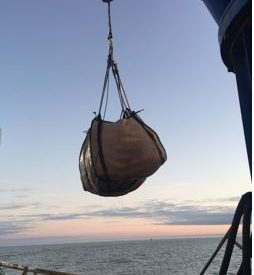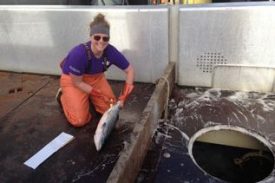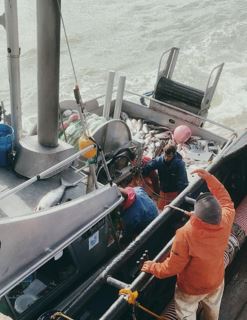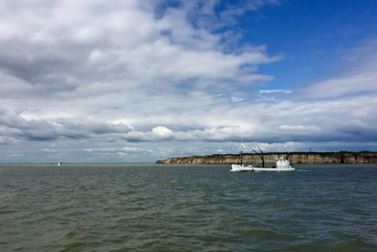SMEA Summer: Who’s buying salmon on the South Line?
By Cori Currier and Emilie Franke

“Now’s a good time! Throw me your duffel,” the crew shouted as the two salmon tender boats pulled alongside one another. It was around 1 AM, and the Alaskan sun had just set over the low-lying green hills on the west side of Nushagak Bay. The 2018 Bristol Bay sockeye salmon summer was in full swing, and it was time to make the jump from the rail of one familiar tender to a new and unknown tender. The experience of transferring to a new boat occurred unpredictably throughout the season and was akin to traveling between two worlds in the blink of an eye. For instance, life on the tenders might include listening to talk radio, eating beef and noodles, playing late-night games of Cribbage, or dancing to 50s or metal music before a 4 AM fish-buying session. Such was the unpredictable life of a Quality Control Technician, or “QC”. Beyond the confines of the many salmon tenders, hundreds of metallic fishing boats bobbed like ducks in the surf, waiting to offload the thousands of pounds of slimy salmon that were holding them up from their next set.

Bristol Bay is arguably the most-well known and most valuable wild salmon fishery in the world. This summer’s sockeye salmon run set a new record of 62.3 million sockeye returning to the Bay. Over 40 million sockeye were caught, which is the second largest harvest Bristol Bay has seen. The Alaska Department of Fish & Game manages the fishery based on specific goals for the number of spawning salmon that return to each of five river systems. At the mouth of each river there is a tower called a weir. Every hour on the hour, someone climbs up the weir to count the number of fish that have “escaped”, that is, made it safely up the river to their spawning grounds, safe from fishermen’s nets. What a job! Depending on the escapement numbers, the “opener” is set and announced for the upcoming 24 hours. This period of time when boats can fish is strictly enforced; if a gillnetter is caught dragging a net in the water even one minute after the opener ends, their entire catch for that period may be confiscated. Close to 1,800 fishing boats wait anxiously to set their nets as soon as each opener begins, often running on a meager few hours of sleep in very tight, very smelly quarters. After pulling in their final set for a given opener, or once they have reached maximum fish capacity, boats race to the nearest tender to offload their fish. That’s when we threw on our gear and got ready for the fun.

The QC gig kept us on our toes, despite the repetitive tasks. We spent most of our time squatting over large bins full of slimy, shiny, usually dead, salmon. In addition, we dodged the swinging 1000-pound brailer bags, called out weights, and ran around machinery and ice chests to shovel piles of fish into the holds below deck. Officially, we were responsible for checking each fishing boat’s delivery for specific quality standards, most notably fish temperature and acceptable bleeding practices. Fishermen received a higher price per pound for every quality standard that was met on an individual catch. Are your fish floating? Check. Did you use a mat or a slide to prevent bruising? Check. To ensure that fish are kept cold, many boats installed a refrigerated seawater system, which comes with the added challenge and cost of maintenance. Seafood companies also give a bonus for bleeding, which reduces bruising and improves the appearance and quality of the meat. Many boats hire an extra deckhand for part or all of the season in order to bleed as many fish as possible while continuing to pull in nets quickly. Working as QCs gave us a unique view into how the increasing consumer demand for whole fillets, as opposed to canned salmon, impacts vessel operations at sea. Even on seemingly endless nights, as we dashed from port to starboard clutching slimy thermometers and scribbling numbers on tiny squares of paper (#datacollection), it was hard not to appreciate life on the water. We felt lucky to be part of such a dynamic fishery!

Much of what made the experience memorable was getting to know so many different tenders and their crew members. Tender boats take many forms, but all are large, often over 100 ft, and have a capacity to hold between 100,000 and 1 million pounds of fish. When not supporting the short Bristol Bay fishery, many boats fish for crab, pollock, or other species, aid research in the South Pacific, or go on expeditions to the Arctic. In the summer, they are hired by one of several different seafood companies to buy the freshly-caught salmon directly from fishing boats and deliver it to the companies’ respective processing facilities, either on shore or elsewhere at sea. For many of the crew members, especially crabbers, the Bristol Bay summer is their “down time”. The crews come with stories and personalities that led to many unforgettable moments and conversations. As QCs living with many different crews, we made ourselves useful by pitching in on tasks aboard the tenders. These included creatively combining dwindling ingredients to make a meal, throwing and tying lines, pumping gas, taking an anchor watch, or digging for blocks of frozen cheese in the walk-in freezer.

A book or ten could be written about one summer on the Bay and the thousands of fishermen and seasonal workers who come from all over the world to be part of this fishing frenzy. We were fortunate to gain an on-deck perspective of the inner workings of the fishery and the people who make it what it is. This season, many fishermen fared well, while others swore this would be their last time on the Bay. Back at UW, management of the Bristol Bay salmon fishery often comes up in class discussion, and we can’t help but taste the air and reflect on the blue, grey, and pink hues of this Alaskan summer.